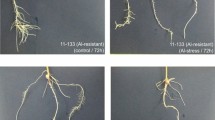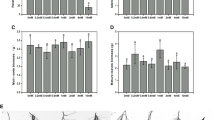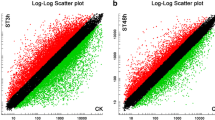Abstract
Oligonucleotide microarrays corresponding to over 16,000 genes were used to analyze changes in transcript accumulation in root tips of the Al-sensitive Medicago truncatula cultivar Jemalong genotype A17 in response to Al treatment. Out of 2,782 genes with significant changes in transcript accumulation, 324 genes were up-regulated and 267 genes were down-regulated at least twofold by Al. Up-regulated genes were enriched in transcripts involved in cell-wall modification and abiotic and biotic stress responses while down-regulated genes were enriched in transcripts involved in primary metabolism, secondary metabolism, protein synthesis and processing, and the cell cycle. Known markers of Al-induced gene expression including genes associated with oxidative stress and cell wall stiffening were differentially regulated in this study. Transcript profiling identified novel genes associated with processes involved in Al toxicity including cell wall modification, cell cycle arrest and ethylene production. Novel genes potentially associated with Al resistance and tolerance in M. truncatula including organic acid transporters, cell wall loosening enzymes, Ca2+ homeostasis maintaining genes, and Al-binding were also identified. In addition, expression analysis of nine genes in the mature regions of the root revealed that Al-induced gene expression in these regions may play a role in Al tolerance. Finally, interfering RNA-induced silencing of two Al-induced genes, pectin acetylesterase and annexin, in A17 hairy roots slightly increased the sensitivity of A17 to Al suggesting that these genes may play a role in Al resistance.





Similar content being viewed by others
Abbreviations
- Al:
-
Aluminum
- ANN:
-
Annexin
- AROS:
-
Array-ready oligo set
- CMF:
-
Cellulose microfibrils
- COB:
-
COBRA-like gene
- CW:
-
Cell wall
- FDR:
-
False discovery rate
- GO:
-
Gene ontology
- MATE:
-
Multidrug and toxin efflux
- PAE:
-
Pectin acetylesterase
- PCD:
-
Programmed cell death
- PE:
-
Pectinesterase
- PM:
-
Plasma membrane
- PME:
-
Pectin methylesterase
- PR:
-
Pathogenesis-related
- q-PCR:
-
Quantitative real-time PCR
- RNAi:
-
Interfering RNA
- ROS:
-
Reactive oxygen species
- TC:
-
Tentative consensus
References
Ahn SJ, Sivaguru M, Chung GC, Rengel Z, Matsumoto H (2002) Aluminium-induced growth inhibition is associated with impaired efflux and influx of H+ across the plasma membrane in root apices of squash (Cucurbita pepo). J Exp Bot 53:1959–1966
Allison JD, Brown DS, Novo-Gradac KJ (1991) MINTEQA2/PRODEFA2, a geochemical assessment model for environmental systems, v 3.0 User’s manual; U.S. EPA; Athens, GA
Arnholdt-Schmitt B (2004) Stress-induced cell reprogramming. A role for global genome regulation? Plant Physiol 136:2579–2586
Blancaflor EB, Jones DL, Gilroy S (1998) Alterations in the cytoskeleton accompany aluminum-induced growth inhibition and morphological changes in the primary roots of maize. Plant Physiol 118:159–172
Boisson-Dernier A, Chabaud M, Garcia F, Becard G, Rosenberg C, Barker DG (2001) Agrobacterium rhizogenes-transformed roots of Medicago truncatula for the study of nitrogen-fixing and endomycorrhizal symbiotic associations. Mol Plant Microbe Interact 14:695–700
Boscolo PR, Menossi M, Jorge RA (2003) Aluminum-induced oxidative stress in maize. Phytochemistry 62:181–189
Brodersen P, Petersen M, Pike HM, Olszak B, Skov S, Odum N, Jorgensen LB, Brown RE, Mundy J (2002) Knockout of Arabidopsis accelerated-cell-death11 encoding a sphingosine transfer protein causes activation of programmed cell death and defense. Genes Dev 16:490–502
Bucher M, Brunner S, Zimmermann P, Zardi GI, Amrhein N, Willmitzer L, Riesmeier JW (2002) The expression of an extensin-like protein correlates with cellular tip growth in tomato. Plant Physiol 128:911–923
Cassab GI (1998) Plant cell wall proteins. Annu Rev Plant Physiol Plant Mol Biol 49:281–309
Chen C, Dickman MB (2005) Proline suppresses apoptosis in the fungal pathogen Colletotrichum trifolii. Proc Natl Acad Sci USA 102:3459–3464
Chen D, Liang M-X, Dewald D, Weimer B, Peel MD, Bugbee B, Michaelson J, Davis E, Yajun W (2008) Identification of dehydration responsive genes from two non-nodulated alfalfa cultivars using Medicago truncatula microarrays. Acta Physiol Plant 30:183–199
Ciamporova M (2002) Morphological and structural responses of plant roots to aluminum at organ, tissue and cellular levels. Biol Plant 45:161–171
Clark G, Cantero-Garcia A, Butterfield T, Dauwalder M, Roux SJ (2005) Secretion as a key component of gravitropic growth: implications for annexin involvement in differential growth. Gravit Space Biol Bull 18:113–114
Clark GB, Sessions A, Eastburn DJ, Roux SJ (2001) Differential expression of members of the annexin multigene family in Arabidopsis. Plant Physiol 126:1072–1084
Cruz-Ortega R, Cushman JC, Ownby JD (1997) cDNA clones encoding 1, 3-β-glucanase and a fimbrin-like cytoskeletal protein are induced by Al toxicity in wheat roots. Plant Physiol 114:1453–1460
Darko E, Ambrus H, Stefanovits-Banyai E, Fodor J, Bakos F, Barnabas B (2004) Aluminum toxicity, Al tolerance and oxidative stress in an Al-sensitive wheat genotype and in Al-tolerant lines developed by an in vitro microspore selection. Plant Sci 166:583–591
De Carvalho-Niebel F, Lescure N, Cullimore JV, Gamas P (1998) The Medicago truncatula MtAnn1 gene encoding an annexin is induced by Nod factors and during the symbiotic interaction with Rhizobium meliloti. Mol Plant Microbe Interact 11:504–513
De Carvalho-Niebel F, Timmers AC, Chabaud M, Defaux-Petras A, Barker DG (2002) The Nod factor-elicited annexin MtAnn1 is preferentially localized at the nuclear periphery in symbiotically activated root tissues of Medicago truncatula. Plant J 32:343–352
Delhaize E, Gruber BD, Ryan PR (2007) The roles of organic anion permeases in aluminium resistance and mineral nutrition. FEBS Lett 12:2255–2262
Delisle G, Champoux M, Houde M (2001) Characterization of oxalate oxidase and cell death in Al-sensitive and tolerant wheat roots. Plant Cell Physiol 42:324–333
Delmer DP, Potikha TS (1997) Structures and functions of annexins in plants. Cell Mol Life Sci 53:546–553
Devi SR, Yamamoto Y, Matsumoto H (2003) An intracellular mechanism of aluminum tolerance associated with high antioxidant status in cultured tobacco cells. J Inorg Biochem 97:59–68
Durrett TP, Gassmann W, Rogers EE (2007) The FRD3-mediated efflux of citrate into the root vasculature is necessary for efficient iron translocation. Plant Physiol 144:197–205
Dykema PE, Sipes PR, Marie A, Biermann BJ, Crowell DN, Randall SK (1999) A new class of proteins capable of binding transition metals. Plant Mol Biol 41:139–150
Eticha D, Stass A, Horst WJ (2005) Cell-wall pectin and its degree of methylation in the maize root-apex: significance for genotypic differences in aluminum resistance. Plant Cell Environ 28:1410–1420
Foy CD, Chaney RL, White MC (1978) The physiology of metal toxicity in plants. Annu Rev Plant Physiol 29:511–566
Frantzois G, Galatis B, Apostolakos P (2000) Aluminium effects on microtubule organization in dividing root-tip cells of Triticum turgidum. I. Mitotic cells. New Phytol 145:211–224
Furukawa N, Yamaji H, Wang N, Mitani Y, Murata K, Sato M, Katsuhara K, Takeda, Ma JF (2007) An aluminum-activated citrate transporter in barley. Plant Cell Physiol 48:1081–1091
Hamel F, Breton C, Houde M (1998) Isolation and characterization of wheat aluminum-regulated genes: possible involvement of aluminum as a pathogenesis response elicitor. Planta 205:531–538
Helliwell CA, Wesley SV, Wielopolska AJ, Waterhouse PM (2002) High-throughput vectors for efficient gene silencing in plants. Funct Plant Biol 29:1217–1225
Hong JK, Hwang BK (2005) Induction of enhanced disease resistance and oxidative stress tolerance by over expression of pepper basic PR-1 gene in Arabidopsis. Physiol Plant 124:267–277
Jennings DB, Ehrenshaft M, Pharr DM, Williamson JD (1998) Roles for mannitol and mannitol dehydrogenase in active oxygen-mediated plant defense. Proc Natl Acad Sci USA 95:15129–15133
Journet EP, van Tuinen D, Gouzy J, Crespeau H, Carreau V, Farmer MJ, Niebel A, Schiex T, Jaillon O, Chatagnier O, Godiard L, Micheli F, Kahn D, Gianinazzi-Pearson V, Gamas P (2002) Exploring root symbiotic programs in the model legume Medicago truncatula using EST analysis. Nucleic Acids Res 30:5579–5592
Kang CH, Jung WY, Kang YH, Kim JY, Kim DG, Jeong JC, Baek DW, Jin JB, Lee JY, Kim MO, Chung WS, Mengiste T, Koiwa H, Kwak SS, Bahk JD, Lee SY, Nam JS, Yun DJ, Cho MJ (2006) AtBAG6, a novel calmodulin-binding protein, induces programmed cell death in yeast and plants. Cell Death Differ 13:84–95
Kinraide TB (1991) Identity of the rhizotoxic aluminum species. Plant Soil 134:167–178
Klessig DF, Durner J, Noad R, Navarre DA, Wendehenne D, Kumar D, Zhou JM, Shah J, Zhang S, Kachroo P, Trifa Y, Pontier D, Lam E, Silva H (2000) Nitric oxide and salicylic cid signaling in plant defense. Proc Natl Acad Sci USA 97:8849–8855
Kochian LV, Piñeros MA, Hoekenga OA (2005) The physiology, genetics and molecular biology of plant aluminum resistance and toxicity. Plant Soil 274:175–195
Kuge S, Jones N (1994) YAP1 dependent activation of TRX2 is essential for the response of Saccharomyces cerevisiae to oxidative stress by hydroperoxides. EMBO J 13:655–664
Larsen PB, Geisler MJ, Jones CA, Williams KM, Cancel JD (2005) ALS3 encodes a phloem-localized ABC transporter-like protein that is required for aluminum tolerance in Arabidopsis. Plant J 41:353–363
Larsen PB, Cancel J, Rounds M, Ochoa V (2007) Arabidopsis ALS1 encodes a root tip and stele localized half type ABC transporter required for root growth in an aluminum toxic environment. Planta 225:1447–1458
Lazof DB, Goldsmith JG, Rufty TW, Linton RW (1994) Rapid uptake of aluminum into cells of intact soybean root tips: A microanalytical study using secondary ion mass spectrometry. Plant Physiol 106:1107–1114
Lohar DP, Sharopova N, Endre G, Penuela S, Samac D, Town C, Silverstein KA, VandenBosch KA (2006) Transcript analysis of early nodulation events in Medicago truncatula. Plant Physiol 140:221–234
Ma JF, Shen R, Nagao S, Tanimoto E (2004) Aluminum targets elongating cells by reducing cell wall extensibility in wheat roots. Plant Cell Physiol 45:583–589
Magalhaes JV, Liu J, Guimarães CT, Lana UGP, Alves VMC, Wang Y-H, Schaffert RE, Hoekenga OA, Piñeros MA, Shaff JE, Klein PE, Carneiro NP, Coelho CM, Trick HN, Kochian LV (2007) A gene in the multidrug and toxic compound extrusion (MATE) family confers aluminum tolerance in sorghum. Nat Genet 39:1156–1161
Manthey K, Krajinski F, Hohnjec N, Firnhaber C, Puhler A, Perlick AM, Kuster H (2004) Transcriptome profiling in root nodules and arbuscular mycorrhiza identifies a collection of novel genes induced during Medicago truncatula root endosymbioses. Mol Plant Microbe Interact 17:1063–1077
Mao C, Yi K, Yang L, Zheng B, Wu Y, Liu F, Wu P (2004) Identification of aluminum-regulated genes by cDNA-AFLP in rice (Oryza sativa L.): aluminum-regulated genes for the metabolism of cell wall components. J Exp Bot 55:137–143
Mariano ED, Jorge RA, Keltjens WG, Menossi M (2005) Metabolism and root exudation of organic acid anions under aluminium stress. Braz J Plant Physiol 17:157–172
Massot N, Nicander B, Barceló J, Poschenrieder Ch, Tillberg E (2002) A rapid increase in cytokinin levels and enhanced ethylene evolution precede Al3+-induced inhibition of root growth in bean seedlings (Phaseolus vulgaris L.). Plant Growth Regul 37:1573–1587
Matsumoto H (1988) Changes of the structure of pea chromatin by aluminum. Plant Cell Physiol 29:281–287
Matsumoto H, Hirasawa E, Torikai H, Takahashi E (1976) Localization of absorbed aluminum in pea root and its binding to nucleic acids. Plant Cell Physiol 17:127–137
Matsumoto H, Morimura S (1980) Repressed template activity of chromatin of pea roots treated by aluminum. Plant Cell Physiol 21:951–959
Pence NS, Larsen PB, Ebbs SD, Letham DL, Lasat MM, Garvin DF, Eide D, Kochian LV (2000) The molecular physiology of heavy metal transport in the Zn/Cd hyperaccumulator Thlaspi caerulescens. Proc Natl Acad Sci USA 97:4956–4960
Rengel Z, Zhang WH (2003) Role of dynamics of intracellular calcium in aluminium-toxicity syndrome. New Phytol 159:295–314
Ragland M, Soliman KM (1997) Sali-4a (Accession No. U64866) and Sali3-2 (Accession No. U89693). Two genes induced by aluminum in soybean roots. Plant Physiol 114:395
Richards KD, Schott EJ, Sharma YK, Davis KR, Gardner RC (1998) Aluminum induces oxidative stress genes in Arabidopsis thaliana. Plant Physiol 116:409–418
Ryan PR, Ditomaso JM, Kochian LV (1993) Aluminum toxicity in roots: An investigation of spatial sensitivity and the role of the root cap. J Exp Bot 44:437–446
Sasaki M, Yamamoto Y, Matsumoto H (1996) Lignin deposition induced by aluminum in wheat (Triticum aestivum) roots. Physiol Plant 96:193–198
Sasaki T, Ezaki B, Matsumoto H (2002) A gene encoding multidrug resistance (MDR)-like protein is induced by aluminum and inhibitors of calcium flux in wheat. Plant Cell Physiol 43:177–185
Schildknecht PHPA, Vidal BC (2002) A role for the cell wall in Al3+ resistance and toxicity: crystallinity and availability of negative charges. Int Arch Biosci 2000:1087–1095
Schindelman G, Morikami A, Jung J, Baskin TI, Carpita NC, Derbyshire P, McCann MC, Benfey PN (2001) COBRA encodes a putative GPI-anchored protein, which is polarly localized and necessary for oriented cell expansion in Arabidopsis. Genes Dev 15:1115–1127
Schmohl N, Pilling J, Fisahn J, Horst WJ (2000) Pectin methylesterase modulates aluminum sensitvity in Zea mays and Solanum tuberosum. Physiol Plant 109:419–427
Silva IR, Smyth TJ, Moxley DF, Carter TE, Allen NS, Rufty TW (2000) Aluminum accumulation at nuclei of cells in the root tip. Fluorescence detection using lumogallion and confocal laser scanning microscopy. Plant Physiol 123:543–552
Simonovicova M, Huttova J, Mistrik I, Siroka B, Tamas L (2004) Root growth inhibition by aluminum is probably caused by cell death due to peroxidase-mediated hydrogen peroxide production. Protoplasma 224:91–98
Sivaguru M, Horst WJ (1998) The distal part of the transition zone is the most aluminum sensitive apical root zone of maize. Plant Physiol 116:155–163
Sivaguru M, Pike S, Gassman W, Baskin TI (2003) Aluminum rapidly depolymerizes cortical microtubules and depolarizes the plasma membrane: evidence that these responses are mediated by a glutamate receptor. Plant Cell Physiol 44:667–675
Snowden KC, Richards KD, Gardner RC (1995) Aluminum-induced genes. Induction by toxic metals, low calcium, and wounding and pattern of expression in root tips. Plant Physiol 107:341–348
Solomon M, Belenghi B, Delledonne M, Menachem E, Levine A (1999) The involvement of cysteine proteases and protease inhibitor genes in the regulation of programmed cell death in plants. Plant Cell 11:431–444
Sugimoto K, Williamson RE, Wasteneys GO (2000) New techniques enable comparative analysis of microtubule orientation, wall texture, and growth rate in intact roots of Arabidopsis. Plant Physiol 124:1493–1506
Sun P, Tian QY, Zhao MG, Dai XY, Huang JH, Li LH, Zhang WH (2007) Aluminum-induced ethylene production is associated with inhibition of root elongation in Lotus japonicus L. Plant Cell Physiol 48:1229–1235
Tamas L, Huttova J, Mistrik I (2003) Inhibition of Al-induced root elongation and enhancement of Al-induced peroxidase activity in Al -sensitive and Al-resistant barley cultivars are positively correlated. Plant Soil 250:193–200
Tesfaye M, Samac DA, Vance CP (2006) Insights into symbiotic nitrogen fixation in Medicago truncatula. Mol Plant Microbe Interact 19:330–341
Tusher VG, Tibshirani R, Chu G (2001) Significance analysis of microarrays applied to the ionizing radiation response. Proc Natl Acad Sci USA 98:5116–5121
Vazquez MD (2002) Aluminum exclusion mechanism in root tips of maize (Zea mays L.): Lysigeny of aluminum hyperaccumulator cells. Plant Biol 4:234–249
Vercauteren I, de Almeida Engler J, De Groodt R, Gheysen G (2002) An Arabidopsis thaliana pectin acetylesterase gene is upregulated in nematode feeding sites induced by root-knot and cyst nematodes. Mol Plant Microbe Interact 15:404–407
Wen F, Zhu Y, Hawes MC (1999) Effect of pectin methylesterase gene expression on pea root development. Plant Cell 11:1129–1140
Yamamoto Y, Kobayashi Y, Matsumoto H (2001) Lipid peroxidation is an early symptom triggered by aluminum, but not the primary cause of elongation inhibition in pea roots. Plant Physiol 125:199–208
Zheng SJ, Yang JL (2005) Target sites of aluminum phytotoxicity. Biol Plant 49:321–331
Acknowledgments
This work was supported by the National Science Foundation Plant Genome Project (award no. 0110206) and USDA-ARS. We thank Dr. Susan C. Miyasaka (University of Hawaii) for providing us with the media composition for Al-plate assays, Dr. David Galbraith (University of Arizona) for printing of microarrays, Dr. Dasharath P. Lohar (University of Minnesota) for microarray slide scanning and Dr. Judy Schnurr for assistance with RNA blots. We acknowledge support from the University of Minnesota Super Computing Institute for data analysis. This paper is a joint contribution from the Plant Science Research Unit, USDA, Agricultural Research Service and the Minnesota Agricultural Experiment Station. Mention of a trademark, proprietary product or vendor does not constitute a guarantee or warranty of the product by the USDA, and it does not imply its approval to the exclusion of other products and vendors that might also be suitable.
Author information
Authors and Affiliations
Corresponding author
Electronic supplementary material
Below is the link to the electronic supplementary material.
Rights and permissions
About this article
Cite this article
Chandran, D., Sharopova, N., Ivashuta, S. et al. Transcriptome profiling identified novel genes associated with aluminum toxicity, resistance and tolerance in Medicago truncatula . Planta 228, 151–166 (2008). https://doi.org/10.1007/s00425-008-0726-0
Received:
Accepted:
Published:
Issue Date:
DOI: https://doi.org/10.1007/s00425-008-0726-0




